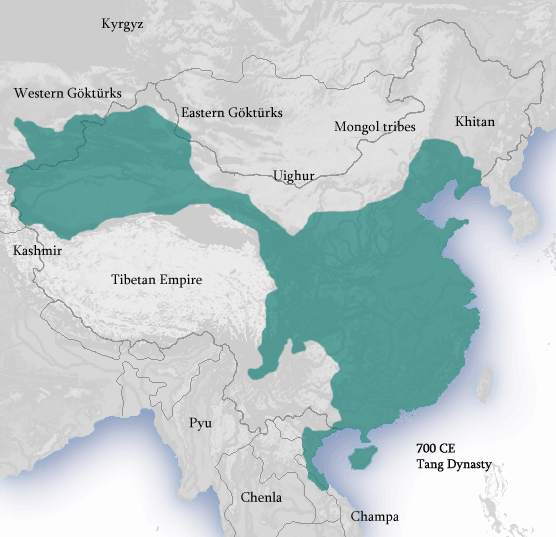25. The Second Unification of China (581 – 907)
Summary China was for the second time unified under the Sui dynasty (581-618) and the Tang dynasty (618-907). This age is often seen as the peak of the history of the Chinese civilization, as society was populous and largely in peace, scholar-officials were recruited by standardized examinations and poetry flourished. During the following Song dynasty (960-1279), which was under pressure from northern nomadic invaders, China was the technologically most advanced state in the world, and remained to be so for many centuries.
Keywords Buddhism; History of East Asia; Song Dynasty of China; Tang Dynasty of China

Map of China under the Tang dynasty. (© Ian Kiu / Wikimedia Commons / CC-BY-SA-3.0)
After the collapse of the Han dynasty (206 BCE – 220 CE) China entered an era of disunity. During this era Buddhism, a religion which originated from India, slowly rose to prominence. Buddhism, which is based on the teaching of Gautama Buddha who lived around 500 BCE, was widespread in India during the Maurya Empire (322-185 BCE), and then spread further to China via the Central Asian Silk Road under the cultural influence of the Kushan Empire (30-375 CE) which encompassed northern India and parts of Central Asia, and here especially under the rule of Kanishka the Great (r. about 127-150). In China Buddhism was backed by the Northern Wei dynasty (386-535). In the following centuries Chinese Buddhist monks travelled back to India to get closer to the roots of Buddhism, the most famous of which were Faxian in the 4th century who visited the prospering Indian Gupta Empire (319-543), and Xuanzang in the 7th century whose travel inspired the Chinese classical Ming novel “Journey to the West”. While Buddhism declined in India during the second half of the 1st millennium CE, it flourished in China and spread further to Korea, Japan and Vietnam. The rise of Buddhism in the east can be compared to the rise of Christianity in Europe during the Roman Empire and the Holy Roman Empire, and to the rise of Islam between the Iberian Peninsula and the Indus Valley.

The Chinese emperor Xuanzong of Tang (r. 713-756) observes Li Bai (701-762) writing poetry. Li Bai is one of the most famous poets in Chinese history. The painting itself dates from the 17th century. (© Anonymous / Wikimedia Commons / Public Domain)
China was for the second time unified by the short-lived Sui dynasty (581-618). During this time the Grand Canal from Hangzhou in the south to Beijing in the north was built, which is the longest canal in the world and was mainly used to transport grain from the fertile Yangtze delta to the north. The Sui dynasty was succeeded by the longer-lived Tang dynasty (618-907), whose rule is generally considered to represent a Golden Age in Chinese history. In Tang China the society was populous and largely in peace, and highly skilled scholar-officials were recruited in standardized imperial examinations. Around 650-800 the capital Chang’an (now Xi’an) was the biggest city in the world with about one million inhabitants, and the empire had a significant degree of control over Central Asia along the Silk Road. Chinese poetry flourished, with two famous poets being Li Bai and Du Fu. Tang rule was briefly interrupted by the rule of empress Wu Zetian (r. 690-705), a former concubine of emperor Taizong (r. 626-649) and former wife of his son – from another woman – emperor Gaozong (r. 649-683). The An Lushan Rebellion (755-763) was a major catastrophe which put an end to the initial splendor of the Tang dynasty. While Buddhism was supported by the Tang emperors in the beginning, Buddhists were persecuted and lost in power during the 9th century, with many Chinese rather venerating Confucius or the Taoist pantheon.
After the fall of the Tang dynasty China was split during the Five Dynasties and Ten Kingdoms period (907-979), until it was reunified by the Song dynasty (960-1279). While the Song emperors ruled over a mighty state from their capital Bianjing (now Kaifeng), they had to retreat from northern nomadic invaders, which had crossed the Great Wall of China, and had to relocate their capital to Lin’an (now Hangzhou), which became the biggest city in the world in the 13th century. While China was not politically unified at that time, it was the technologically most advanced state in the world, as the Four Great Inventions of China were already in use: Papermaking had already been invented during the Han dynasty, and the first paper currency was issued during the Song dynasty. Printing evolved during the Tang dynasty, was initially often used for Buddhist texts and was further developed during the Song dynasty. And both the compass was used for navigation and gunpowder was used for weapons since the Song dynasty. Its advanced technology, however, did not prevent the Song empire from the conquest by the Mongols in the 13th century, which represents one of the darkest chapters of the history of China and of humankind.
